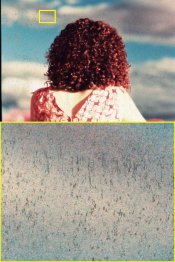Omnibus reply...
Is EIR actually a straight-E6 process film?
Per box, it may be processed in either E-6 or the more uncommon AR-5 chemistry.
What I'm experiencing, however, seems to be lab-specific, as my previous EIR processed at a different lab didn't suffer from this artifact.
Seems like retained silver pointing to insufficient bleaching. Maybe PE can throw more light.
This seems to make sense, although I'm not a chemist.
At the moment, I do all my colour/E6 through the Lab and have never had any issue. Good prices, super quick processing (same day), and it's on my way into work. They're the kind of lab that gives you your negs, turns on the lightbox in the counter, and gets you to inspect the film in front of them before they let you pay for it. Highly recommended.
With exception that I can't personally hike to Vancouver every time I want to review the film I sent in previously, their willingness to allow for inspection on site is good service practice of any pro lab. To be clear, the handler for sending my film to Montréal, VCG in Toronto, were pretty accommodating and allowed me to inspect the film on site before I paid for processing. I expressed mild concern about the artifacts, which was only just-resolvable under a loupe, but it wasn't until I began to scan at home (Plustek OpticFilm) when I could see precisely what was going on at a granular level.
Old film? If I recall, EIR started out as an E4 process. The switch to E6 came fairly late in the game. E4 was an 85 degree process. If this film is really old, you are lucky if you only got a little reticulation!
Very old EIR, pre-1980s, sure. What I was using was EIR dated 5/2004 and 11/2007 — last batches sourced from probably the same master roll, I'm guessing. And from these batches, I'd previously processed stuff without these artifacts appearing.
It saddens me that a city the size of Toronto can't seemingly support at least one e-6 lab.
It saddens me greatly, but that's the way things are in a city where the several industries supported by imaging — fashion, architecture, entertainment, journalism, PR — demand instant turnaround. I remain disappointed by TIW's retirement of their E-6 service. Although my first E-6 order with them years ago got screwed up on their end (they misread their own instructions on a push), they more than made up for it with every order I sent their way thereafter.
Anyway, if you want another option in Ontario, there's GPC labworks in Ottawa
http://www.gpclabworks.com/ . I've had about 15 rolls done through them over the last year and the quality is always excellent. Their turnaround time seems to be about 1-3 days from my experience, so I guess they have still have a good amount of demand?
I haven't heard about Ottawa still being an option, but I'll look into it. Whether Ottawa or Vancouver, I'll have to Purolator or FedEx it.
When I asked how long he plans to offer e-6 development, they were adamant that they will run an e-6 line "as long as someone in the world makes e-6 chemicals", so their attitude is pretty great too

Very promising!
Don't you have a Fujicolor lab in Canada?
Not any longer. Until about 2009, there was one still running in Hamilton, and it's where local drug store photo labs sent their (rare) E-6 and even K-14 orders. With K-14, of course, they simply were a forwarding byway for Parsons, KS.
Thanks to this thread I now know that infra-red Ektachrome in E6 exists -- I always thought that it was E4 till the end. What filter was the OP using I wonder? IIRC a dark yellow would result in a very 'false-colour' result which was actually useful for something or other (besides detecting IR non-reflective materials for the military).
As far as I've been aware, EIR was E-6-compatible for a long time. I know PE would know more precisely, but it seems the switchover occurred sometime during the 1980s, since I've seen old EIR boxes with late '80s expiry dates which were the same process suggestions as the final batches sold in the late 2000s.
With
my 2009 batch of shooting, as with my 2015 batch, I always use an orange G/21/O56 filter. I've always preferred EIR's rendering with that range over using yellower (15/16) or redder (23A) filters — too cold and too severe, respectively. In 2009, I used a Hoya G. In 2015, I've used both a Tiffen 21 (as with my OP example) and a Kenko SO-56.
In the interest of clarity, in its day, in North America there were lots of independent E6 labs, and the film/chemistry/machinery manufacturers were extremely competitive in their efforts to equip and supply them.
Seconding MattKing. Even in a medium-sized city like Minneapolis, where I did much of my shooting between 1998 to 2002, there were no fewer than three major pro E-6 labs (and possibly more I've long forgotten) — NCE and Procolor (at both labs, Hennepin and Ford). All were quite busy with film processing, K-14 excepted.




